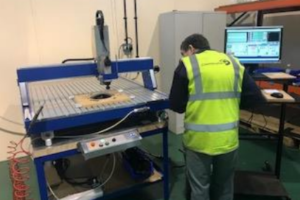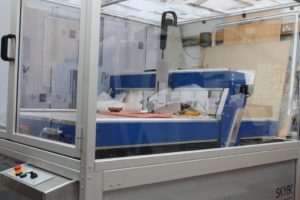January 26, 2017

Conducting Polymers (CPs) are a new class of electronic materials which have become increasingly attractive since their discovery in 1977. The entire field of ‘conducting polymers’ was recognised when Alan Heeker, Hideki Shirikawa and Alan MacDiarmid won the Nobel Prize in 2000 in Chemistry for their work in conducting polymers.
There are two main groups of applications for these polymers. The first group utilises their conductivity as its main property. The second group utilises their electro-activity. Conductive polymers are not thermoplastics but, like insulating polymers, they are organic materials. Compared to non-conducting polymers they have many advantages due to their electronic and optic properties. Since their discovery, many scientists have been working on finding applications for the conducting polymers such as thin film transistors;
Until 30 years ago, all carbon-based polymers were rigidly regarded as ‘insulators’ and the thought that plastics could be made to conduct electricity would have been considered to be absurd. Plastics have always been extensively used by the electronics industry for this very property. This very narrow perspective is rapidly changing as a new class of polymers known as ‘intrinsically conductive polymers’ or ‘electroactive polymers’ are being discovered and commercialised. Although this class of polymer is in its infancy, the potential uses of these polymers are quite significant.
Exactly where these materials are going, in the coming years, is difficult to predict. However, they have been used in artificial muscles, fabrication of electronic devices, solar energy conversion, rechargeable batteries, sensors, as well as applications for display devices and photographic films. Below we attempt to discuss some areas where potentially these new polymers could be used as environmentally friendly and cost effective components.
Battery Applications: Chemically, the plastic battery is different from conventional metal-based rechargeable batteries where material from one plate migrates to another plate and back in a reversible chemical reaction. In a conducting plastic battery, only the stored icons of the solution move, the plates are not consumed and reconstituted.
Since conventional battery life is limited by the number of times the plates can be reconstituted, this difference means a longer recharge-cycle lifetime for the plastic batteries. Probably, the most significant commercialisation of conductive polymers was for flexible, long-life batteries produced in quantity by Bridgestone Corp., and Seiko Co., in Japan and by BASF/Varta in Germany.
A potential application for polymer batteries is in battery-powered vehicles. Two key measures of a battery’s suitability for vehicle application are the power density (which determines acceleration and hill climbing ability) and the energy density (which determines the number of miles that can be driven between charges).
Polyacetylene’s power density is 12 times that of ordinary lead acid batteries. Its energy density is also higher – about 50 wh/kg Vs 35 for lead acid batteries. Although plastic batteries are competing against other advanced development batteries with similar capability for this application, they have the unique potential to be made of low cost environmentally benign materials. Supporters of this technology feel that a polymer battery can be part of the battery-powered car of the future.
Companies are testing new shapes and configurations including flat batteries, which can be bent, like cardboard. There is a belief that the new technology will free electronic designers from the many constraints imposed by metal batteries.
Conductive Polymers in Display Devices: A polymer Light-Emitting Diode (LED) is a thin light source in which a polymer is used as the emissive material. The LED’s are attractive for a host of consumer applications as they operate at a low bias voltage. They enable large area devices (T.Vs) to be manufactured inexpensively. Products, which are currently being developed, are small emissive displays and backlights for small Liquid-Crystal Displays (LCD’s) such as smartphones.
Conducting Polymers inside the Human Body: Due to the bio-compatibility of some conducting polymers, they may be used to transport small electric signals through the body, i.e. behave as “artificial nerves”. Perhaps, in the future they be able to make modifications to the brain. The use of polymers with electro-active reaction has led to their use to emulate biological muscles with high toughness, large actuation strain, and inherent vibration damping. This similarity has gained them the name “Artificial Muscles” and offers the potential of developing biologically inspired robots.
Conductive Polymers in Aerospace: Weight is at a premium for aircraft and spacecraft. The use of polymers with density of about 1-g cc-1 rather than 10 g cm-1 for metals is attractive. Moreover, the power ratio of the internal combustion engine is about 676.6 W/kg. This compares to 33.8 W/kg for a battery/electric motor combination. A drop in magnitude of weight could give similar ratios to the internal combustion engine. Modern planes are often made with lightweight composites. This makes them vulnerable to damage from lightning bolts. Therefore, coating aircraft with a conducting polymer can direct the electricity away from the vulnerable internal areas of the aircraft.
Futuristic Applications
One of the most futuristic applications for conducting polymers is ‘smart’ structure. These are items, which alter themselves to make themselves better. An example is a golf club, which adapts in real time to a persons’ tendency to slice or undercut their shots. A more relatable application is vibration control. Smart skis have recently been developed so they do not vibrate during skiing. Other applications of smart structures include active suspension systems on cars, trucks and bridges; damage assessment on boats; automatic damping of buildings and programmable floors for robotics.
Business Forecasts
Growth factors include the increased sensitivity and power of electronic devices, more stringent regulation of electronic noise, rising raw material costs and continued electronics diffusion, especially in higher-end products. ABS, PVC, polyphenylene-based resins Polycarbonate and polyethylene resins account for 70% of all conductive polymers used.
The best opportunities are anticipated for fibre-filled conductive polymers because of performance advantages as well as surface quality and processing improvements. Product components will provide the best market opportunities for conductive polymers due to widespread applications in housings and enclosures based on advantages over metal in weight, cost and design features.
Demand will be stimulated by the high levels of static electricity developed by moving parts and needs to control EMI/RFI emissions. Antistatic packaging will exhibit good growth based on its cost effectiveness in protecting sensitive electronic devices from static discharges during all stages of handling, work surfaces and flooring.
Counterplas have used this technology to produce products for manufacturers which have provided environmentally sound, cost-effect compositions. Examples of successful applications range from household, DIY and automotive application products.
Do you have a product you would like to take to market using conductive polymers? If so make the right connection and contact our sales and technical team on 0121 520 8387 or sales@counterplas.co.uk
Sources

July 04th, 2019
Leading technical injection moulder, Counterplas, has set ambitious growth targets, buoyed by their recent move to a large new facility in South Staffordshire.

February 02th, 2018
Counterplas have invested in the latest Rhino version 5 software, widely acclaimed as the world’s most robust 3-D development platform for specialty modelling, rendering, analysis, and fabrication tools.

January 08th, 2018
We have invested in a new CNC routing system for production of illuminated bespoke street furniture for a new client in Germany. A ‘blank’ is injection moulded and then routed to provide one of 270 variants.